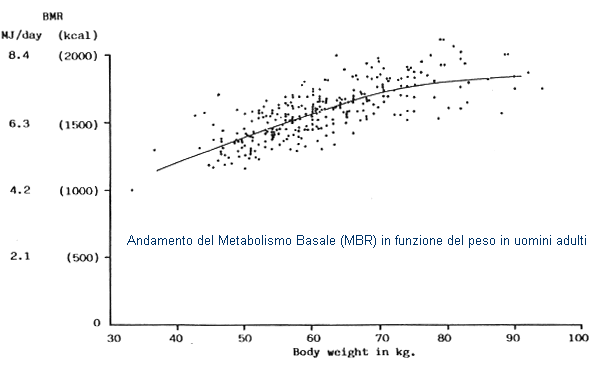The equations of Harris & Benedict they return the amount of energy necessary to support the basal metabolism and the daily caloric requirement.
These are two mathematical formulas that have been accepted in the medical-scientific field for almost a century, since they were developed as far back as 1919. During the last 100 years, however, the lifestyle has changed and the percentage of overweight and obese people has changed. significantly increased (the Harris & Benedict formulas do not take into account the subject's lean mass, which is much more metabolically active than fat, but rather the body surface). Consequently, when applied to severely obese or rather muscular individuals, these formulas lose their accuracy.
Several authors have proposed formulas for calculating the basal metabolic rate in obese subjects.
Bernstein et al .:
Basal metabolic rate in obese men: 11.02 * weight (kg) + 10.23 * height (cm) - 5.8 * age (years) - 1032
Basal metabolic rate in obese women: 7.48 * weight (kg) - 0.42 * height (cm) - 3 * age (years) + 844
Lazzer et al. (NB: results expressed in MJ / day, where one megajoule = 238 KCalories):
Basal metabolic rate in obese men: 0.048 * weight (kg) + 4.655 * Height (m) - 0.020 * age (years) - 3.605;
Basal metabolic rate in obese women: 0.042 * weight (kg) + 3.619 * Height (m) - 2.678.
Huang et al .:
RMR = 71.767 - 2.337 * age + 257.293 * sex (woman = 0, man = 1) + 9.996 * weight (kg) + 4.132 * height (cm) + 145.959 * DM (euglycemic = 0, diabetic = 1)
Mifflin-St.Jeor:
Basal metabolic rate in obese men: (9.99 x weight in kg) + (6.25 x height in cm) - (4.92 x age) + 5.
Basal metabolic rate in obese women: (9.99 x weight in kg) + (6.25 x height in cm) - (4.92 x age) - 161
Why use customized formulas for calculating the basal metabolic rate in obese subjects?
While the opposite is commonly believed, there is little evidence that obese individuals have an inherently low basal metabolic rate. On the other hand, it has been repeatedly shown that under standard conditions the obese have an absolute higher energy requirement than thin people, due to the greater mass of metabolically active tissues. In fact, weight gain is borne by both fat and lean mass; the latter must in fact adapt to support the greater body weight in various daily activities. However, this increase is not linear, since the more weight is gained, the more the weight gain is mainly due to the fat component. Therefore, since the metabolic rate of adipose tissue is much lower than that of muscle, the basal metabolism increases in a curvilinear manner as body weight increases (see figure).
PLEASE NOTE: although in absolute terms (KCal / day) the basal metabolism of obese people is higher than that of people of normal weight, it appears significantly lower in relative terms (KCal / Kg / day), since the percentage of lean mass (metabolically lower) active). It is no coincidence that scholars have long known that, when expressed in terms of lean mass, the basal metabolic rate is rather uniform in the population.



























